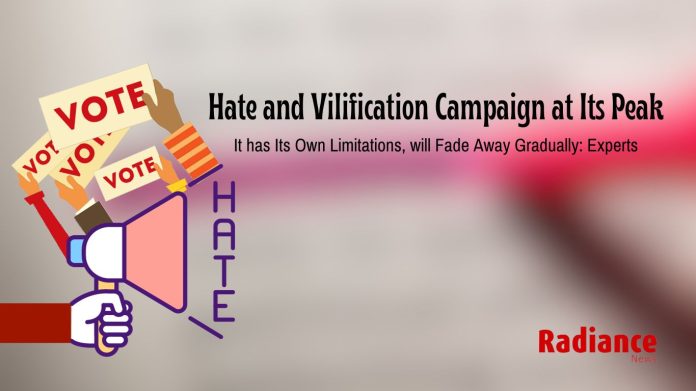“Grassroots journalists and alternative media have to play a big role by countering the hateful campaigns and giving the people the news containing all dimensions of the story.” – Dr Abhay Kumar.

By Mohd Naushad Khan
Decades down the line, hate and anti-Muslim plank has been there in one form or the other. The hate mentality sometimes out of Islamophobia and some other times because of prejudiced mind hates Islam and Muslims. But in the last decade the nature and manifestation of hate campaign has intensified, rather aggressively.
The charged hate pitch generated at regular intervals has led to the social and moral decadence, posing a major threat to our plural ethos and cultural cohesion. On regular basis it is challenging the idea of India and above all the core concept of unity and diversity. The ongoing aggressive hate campaign in the aftermath of the conflict between Israel and Palestine is the culmination of the hate poison induced in the minds of the people over the years out of Islamophobia in particular and anti-Muslim agenda in general.
Disinformation and fake news about Israel’s attacks on Gaza have proliferated on social media, fueled by sites like X (previously Twitter), with a particular emphasis on disseminating anti-Palestinian and Islamophobic sentiments. Scholars have noted that right-wing Indian reports are greatly enhancing the Israeli story for South Asian viewers. The Muslim population in India may be affected in real life by this phenomenon, since violent anti-Muslim prejudice is already pervasive.
According to Amit Sachdeva, Founder Mahatma Foundation and Mahatma Award, “The flood of hate messages on social media and hate campaigns by some news anchors has the potential to profoundly impact our society, particularly in the context of India. It’s essential to recognize that social media platforms have become powerful tools for disseminating information and shaping public opinion. When these platforms are used to spread hate and division, they can exacerbate societal tensions and polarize communities.”
He further said, “The hate messages on social media can fuel real-world violence and discrimination. The digital realm often transcends into the physical, as hate speech can lead to communal unrest and even loss of life. Moreover, it can deepen pre-existing fault lines within Indian society, which is already diverse and multi-faceted. News anchors, who are meant to be impartial conveyors of information, also play a pivotal role. When they engage in hate campaigns, they erode trust in media and exacerbate the problem. This not only undermines the democratic values of a free press but also fans the flames of divisiveness in a nation known for its unity in diversity.”
On the stand of Mahatma Gandhi under the prevailing hate-filled atmosphere, Sachdeva said, “Mahatma Gandhi emphasized that hate is a destructive force that could tear communities apart. He encouraged people to confront hate with understanding, empathy, and peaceful resistance. His famous words, ‘An eye for an eye only ends up making the whole world blind,’ underscore his commitment to breaking the cycle of hatred and revenge. Gandhi’s efforts in the Indian Independence Movement were characterized by his unwavering commitment to non-violence, even in the face of significant adversity and hatred. He believed that by refusing to respond to hate with hate, individuals and communities could eventually overcome divisions and build a more harmonious society.”
On impact of hate in the long run, the founder of Mahatma Foundation, said, “The long-term consequences are alarming. Hate messages and campaigns are damaging social cohesion, hindering our progress, and threatening the very fabric of Indian society. Countering this requires responsible social media use, media ethics, and robust regulation to ensure the responsible dissemination of information. Without these measures, the impact on India could be deeply detrimental.”
Pradeep Mathur, academician, media guru who has served many newspapers at the senior level, said, “The hate campaign is certainly going to impact because it is going to poison people’s mind and there is no doubt about it. Now the only thing we have to see is how long this impact is going to last. Will some be affected by this for their whole life or will it fade away gradually as time passes on. Everybody has to adjust and have a place in the society and be allowed to live in accommodation – this is what a good social atmosphere tells us.
He added, “After this government came, they started hate campaign and the balance that we had in our society has been disturbed. Even the government came, people had the differences, prejudices were there, hate was there but despite all this there was a balance in the society and people kept their prejudices to themselves and now that very balance has been disturbed. After this government came to power, they unleashed sectarian forces which were earlier in the check.”
“The hate campaign and slur are basically of emotional nature but emotions have very short life. The typical example is that in 2013 there were communal riots in Muzaffarnagar between Hindu Jats and Muslims. After few years when the farmers movement started, they said on the same platform and openly regretted and it is on the record that we were fools and it was a mistake on our part to have fought between ourselves despite the fact that we had been living in peace and harmony for the last 100 years,” said Prof Mathur.
“I can see very visible signs of return of people to sanity…. The latest example is voters’ behavior in Karnataka. The hate campaign was failed there,” said Pradeep Mathur.
On its long-term impact, Prof Mathur said, “My point is I can see very visible signs of return of people to sanity. Another example is Pathaan, a film of Shah Rukh Khan which became huge hit despite hate campaign against it. The hate that we see today will fade away as time passes on as it also has its own limitations. I can already see the sign of hate campaign weakening. The latest example is voters’ behavior in Karnataka. The hate campaign was failed there. I can see the visible signs of hate nearing its end gradually.”
Dr Narender Nagarwal, Assistant Professor, Campus Law Centre, Faculty of Law, University of Delhi, while referring to hate campaign unleashed by the anchors of some media houses before and after the conflict began, said, “The spread of communal and hate messages through social media is becoming a major challenge to India’s secular ethos and future of democracy. This is a critical challenge because hate messages are often propagated by some known faces of prominent news channels, and many viewers are unable to distinguish between fact and fiction, leading them to believe and share false information without verifying its authenticity.”
Nagarwal further said, “This uncontrolled spread of hate messages on social media and other platform of digital media can create communal unrest and disrupt social cohesion. If uncivil hate messages, primarily anti-Muslim, are not controlled on different social media platform, the situation of hate crimes and Islamophobic violence may get worse in the coming days. The current state of affairs of Indian news media is appalling as most of the leading news channels and publications have lost their credibility completely.”
Nagarwal added, “The situation became worse when NBSA (independent media body) which is responsible for taking strict action against the hate-mongering news anchors and channels maintained an odd silence and appeared to be encouraging hate-mongering by major news outlets using hateful and targeted content to defame Islam and Muslims on Twitter, Facebook and WhatsApp type platforms. Numerous complaints were previously sent to the Press Council of India and the NBSA, but neither organisation took any action or even cared to respond. This is undoubtedly a troubling time for Indian media.”
Sanjay Kumar, a political analyst and foreign correspondent, said, “It’s the curse of our time that a large section of the mainstream media has become a mouthpiece of the ruling party and its ecosystem that believes that a divided society is the breeding ground for their politics. Anchors are the face of a channel and they are voice of a particular media house. When anchors instead of being a nonpartisan and neutral player and a messenger turns into messenger of hate, it impacts the larger society and audience, which believe that media speaks the truth. But when media becomes a peddler of hate and untruth and propaganda, it affects normal life. Lie and malicious propaganda create an ecosystem that normalise hate in the society.”
Sanjay further said, “And we can see how our society has normalised hatred against Muslims and other minorities, how a vocal section of the society today stands for occupying and repressive forces like Israel and how it demonises the victims in Palestine. Our media and their star anchors are responsible for this moral and political degradation in the society. Anchors are a new menace to the peace in the society. They are responsible for the dumbing down of the media and their credibility loss in the society.”
Dr Abhay Kumar, a columnist and Professor of Political Science at the University of Delhi, said, “The hate messages and hateful campaigns are serious threats to the social fabric and well-being of the society. Indian society is a multicultural one where people from different faiths and creeds have been living for centuries. But the hateful campaigns are trying to tear apart the social fabric. This must stop. But how should we stop this is the important questions. The most important thing is not to forget the fact that the hateful campaigns are not spontaneous, nor are they the results of some crazy people. A few individuals might be posting and writing such poisonous contents out of their communal mindset but the overwhelming majority of the contents promoting communal divisions and polarisation is deliberately manufactured and promoted.”
He further said, “The regime change in 2014 saw the intensification of hateful campaigns because the real agenda of Hindutva regime is not development but serving the interests of a few big corporate giants who have funded the campaigns for Narendra Modi-led BJP. The mainstream media, in turn, is working for spreading the hateful ideology of the Hindutva forces and earning rewards from the establishment by completely violating the ethics of journalism.”
Dr Kumar added, “These trends are very dangerous to the Indian democracy and the only way out is the people’s movement for social harmony and the rights of the people. In this campaign for social justice, grassroots journalists and alternative media have to play a big role by countering the hateful campaigns and giving the people the news containing all dimensions of the story.”




